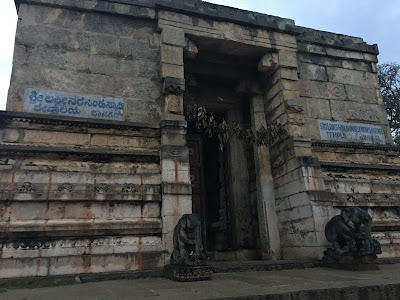Javagallu in rain ....and wanting more.
It was not in the day's plan. But having come so close, how could it be skipped ! So, though short on time, drove into the little hamlet .
This is one fix we get into , in Hoysala country. The Ballalas built and built like possessed , so there's one little gem , famous or little known , at every other village and it becomes too tempting to ignore and pass by when the signboards on the main road start announcing that a certain temple is just 5 or 10kms away .
Daylight was failing and there was the added gloom of drizzly , dark clouds. Nevertheless, a salute to the Narasimha of Javagallu , just yonder, was in order .
Here we go.
Such a small, quiet hamlet, getting drenched in the relentless drizzle. No sign of any activity anywhere, but the broadest dirt road takes us straight to the gate of the medieval temple. The Priest, just hurrying home after lighting the evening lamp , tarries upon seeing us, but requests that we finish our prayers quickly and allow him to go home . Like we'd come on a pilgrimage ! But just to assuage the poor old man, we do a quick round up of the interior , have darshan and a few quick clicks in the very dark interior and bid the priest bye. He gratefully locks up the shrine and leaves us to wander around in the compound. The main Mahadwara , of a later vintage than the temple, is presumably locked only at night. Two chubby Hoysala elephants have been placed there as guards.
The Temple , though of Trikuta design , has only the central shikara , the other two lateral sancta, without towers, seem built into the walls . The temple stands on a jagati as expected of the style . This platform, so favoured by Hoysalas, is quite an ingenious architectural element . It raises the height of the temple and also provides a pradakshinapatha ( Circumambulatory path) for the devotees. The central shikara has a curious looking metal helmet topping it, obviously a replacement for a lost Amalaka ( the original finial).
The outer walls show double eaves , said to be of the "new wave" in Hoysala architecture. The bhitti space between the two eaves is decorated with pilasters and aedicules while the space below the lower eaves is given to 140 images of Vishnu and related divinities. Some scholars have described the styue of these images as relaxed and folksy , but while they do look different from the Halebid icons, I find nothing "folksy and relaxed" in them .
Because of lack of sunlight , finer details are not readily apparent except in a few. But trying to imagine those bygone days when the artisans worked in natural light as was available. There would have been gloomy days like this then too and the sculptors would have chiseled away in the light of oil lamps and theevattis !
The deity in the main sanctum is Sridhara , while Narasimha and Venugopala occupy the lateral cells .
The temple deserves to be seen in better light and at a more leisurely pace . Perhaps if an ardent prayer is sent up for another chance to visit, the various beautiful deities enjoying the evening shower will grant the wish .
Pausing a minute in the open compound , feeling the fine drizzle on the skin . With the tall sthambha and two later day open pavilions bearing witness, I inhale the ancient smell of wet stone and slushy mud .......and pray.
Wishing and waiting ..........
____________________
Factfile :
Temple commissioned in 1250CE by King Vira Someshwara . Renovated and Maintained by ASI today. 50 Kms from Hassan , 20Kms from Halebeedu.
The temple has many signed pieces of artwork . The well known name , Mallitamma, is seen on the pedestals of ten figures . Mallitamma seems to have had a long and prolific career , starting at the end of 12th Century in Amritapura and attaining grand finale in Somanathapura in 1258 . As was the norm of the day , he would have headed a Guild comprising of apprentices and artisans who displayed his style in their work.
Other artists who have left their signatures in stone, in Javagal, are Makasa, Makosa and Chikka Mallitamma )




Comments